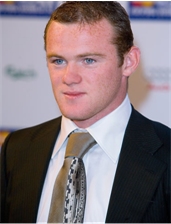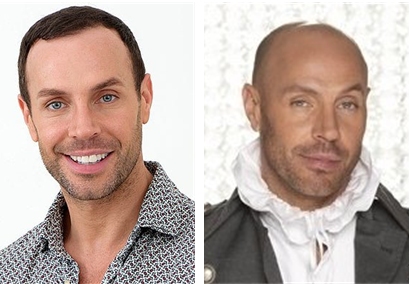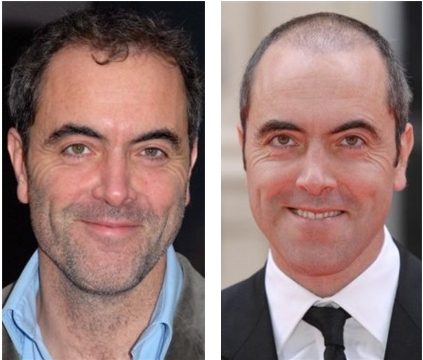»
Hair Loss Home Page »
»
Find a Hairloss Clinic »
HAIR
LOSS ARTICLES
»
Hair Facts & Myths »
»
Hair Loss in Women »
»
Hair Loss in Men »
»
Hair Loss Explained »
»
Before a Specialist »
»
Rare Causes (Hair Loss) »
»
Hair & Hair Confidence »
»
Wigs: Trevor Sorbie »
»
Hair Transplants»
»
Mind over matter »
»
Hair Loss Secrets »
»
Anceint Theories »
|
|
 |
TONY MALEEDY
HAIR ADVICE
|
Hair
Transplants
(and how Wayne’s hair can be even better)
Meet Tony Maleedy our hair specialist with 25 years experience
in clinical practice and hair research. Tony will be regularly
contributing to his column on UKHairdressers and helping you
care for your hair.
On me head son!' Wayne seemed happy to
show his hair transplant off on Twitter. |
With recent documentaries, lower costs, and the news about
Wayne Rooney’s hair, hair transplants are becoming a main
stream and totally acceptable surgical procedure for men.
Hair Transplanting is a surgical technique that involves moving
individual hair follicles from the donor site at the back
of the head to a bald area of the scalp (the recipient site).
The reason this technique is successful is because the hairs
which are transplanted from the back of the head are not genetically
programmed to respond negatively to elevated levels of the
male hormone dihydrotestosterone (DHT), and so will not be
lost as the original hairs were.
Hair transplantation has improved enormously over the last
15 years or so. Originally comparatively large grafts of skin
were transplanted from the back of the scalp to the thinning
areas, and frequently these ‘plugs’ of hair were unsightly.
Indeed, in the past I have come across hair transplants so
badly done eventually all the plugs had to be removed because
they were so embarrassingly unattractive.
But how things have changed! The technique used now is called
micro-grafting. This is where, instead of the large plugs
of skin, very small grafts containing 1 to 4 hairs are inserted
into the thinning area of the scalp, with often spectacular
results. In the right hands this technique results in totally
natural

Wayne's
hair a few years ago, before it started receding.
|
looking
hair which is virtually undetectable even to an expert eye.
Only a few days ago I examined the scalp of a man who had
had a hair transplant ten months previously and who was totally
delighted with the results. Even on close examination it was
extremely difficult for me, as a hair specialist using a magnifying
lens, to tell that the transplanted hairs were not original
to that area of the scalp. For a non-hair specialist it would
be impossible to tell.
But are all hair transplants as good as this? No they are
not, which is a shame because they probably could be. All
too often the hairs do not grow as well as they could simply
because the person’s scalp is not as healthy as it should
be.
Why is a healthy scalp important?
The hair grows from the scalp and depends upon it for its
nourishment and well-being, similar to a rich fertile soil
needed for plants to grow and flourish. So when the scalp
becomes unhealthy it shows in the hair. Dryness, dandruff,
irritation, inflammation, hair loss and much more can all
be symptoms of an unhealthy scalp, but improving the health
of the scalp leads to enormous improvements, not just to the
scalp itself but also to the quality and condition of the
hair and its ability to grow.

In
2011, Jason Gardiner spent £35,000 having 3,500 hairs
transplanted from the back of his head to the top. It
took 8 hours and worked out at £10 per hair. After the
transplant he had to wait around 6 months for the hair
to regrow and revealed his new look while on the judge's
panel of the TV show Dancing on Ice.

Left: James Nesbitt in 2009 after his hair transplant
and (right) in 2007 |
The
health of the scalp is particularly important in relation
to hair transplants. A healthy scalp is more likely to allow
newly transplanted follicular root systems to settle into
position well, for any scabs or crusts to heal at a faster
rate and for the regenerated hair to grow more vigorously.
Improving the health of the scalp is a simple thing to do
and yet can make an enormous difference to the quantity of
new hair growing from transplants.
A highly effective method of achieving and maintaining a healthy
scalp, particularly before and after hair transplant surgery,
is to use the clinically developed therapeutic shampoo, Juniper
Mint Scalp Therapy Shampoo.
Juniper Mint Scalp Therapy Shampoo
It’s worth knowing that a leading hair transplant clinic uses
the Juniper Mint Shampoo after the transplant procedure as
it has been proven to aid hair growth performance.
This is a unique shampoo treatment made using a rich blend
of natural therapeutic oils, juniper, white thyme, tea tree,
rosemary and corn mint oil, all of which have natural anti-microbial
and antiseptic properties. These ingredients, combined together
in an exceptionally high quality conditioning shampoo base,
can have dramatic improvements to the health of the scalp
and hair because of their soothing and calming effect on scalp
tissues and an improvement to the environment in which the
hair grows.
|
|